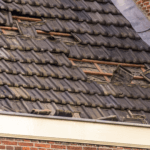
Despite its peak seasons being in the spring and fall months, hail can become a nuisance to commercial property owners year-round. While some hailstorms may result in minimal to no property damage, larger and more powerful hailstorms have the potential to cause significant damage – especially to roof systems. There are several reasons why business owners should file a commercial property damage insurance claim for roof hail damage as soon as possible.
Commercial Roof Hail Damage Claims
Hail has proven it can pack a serious punch to Texas commercial property owners. According to the Insurance Information Institute (III), in 2021, over 1.5 million properties in the Lone Star State suffered hail damage. This accounted for nearly a quarter of the total affected properties nationwide, with roof damage being a common result.
Despite a large number of hail-damaged properties in Texas, some may be unaware of the risks that come with unrepaired roof hail damage. Businesses that have relocated to Texas in recent years could particularly be at risk, especially if they are unfamiliar with the ever-changing weather our state experiences. Not only that, but it can be much more difficult to have a commercial property damage claim accepted the longer a policyholder waits to file it with their insurer.
There are a multitude of reasons why hail-damaged roof systems pose significant risks to businesses if they are left unrepaired and an insurance claim is not filed. Particularly, reporting claims promptly removes the potential for an insurance provider to deny a claim for not being filed closer to the date of the event. However, insurers may still argue that the damage was due to normal wear and tear or even that it was the result of unrepaired damage that occurred before the hailstorm. In addition, even if the insurer agrees to cover the roof damage, they can cite late reporting as another reason to only pay a portion of the claim costs rather than the full amount. Texas also has strict time limitations within which a lawsuit can be filed in the event a valid property damage claim is wrongly denied. Particularly, the state has a two-year statute of limitations that runs from the date of the event within which a hail damage lawsuit must be filed. After the two years have passed, policyholders lose the right to legal recourse.
Another reason why commercial policyholders should file their roof hail damage claims promptly is that, if not properly inspected, it can take weeks or even longer to discover the full extent of roof hail damage. In some cases, business owners may only become aware of it after the water has already entered the building through the damaged roof and caused further damage to the interior of the property. This is yet another reason why property owners must be diligent in finding and reporting the damage as quickly as possible to avoid additional property damage, further business disruptions, and additional insurance claims obstacles.
A hailstorm won’t just impact a singular property either. Adjacent properties in the area are likely to also suffer similar hail damage. Because of this, carriers are likely to see a high volume of filed claims that must be processed. This can leave insureds waiting long periods before their property damage can be reviewed or even repaired. Contractors can quickly become overwhelmed with requests in these situations, which can delay repairs and ultimately add to the losses suffered and thus the overall cost of a claim if it is not filed promptly.
Roof Hail Damage: What To Look For
After a hailstorm, commercial property owners should have an experienced roofer inspect their roof damage to determine the overall extent. It’s important to note that this type of damage can look different from property to property depending on the types of roof materials. Asphalt, for instance, is one of the most popular roofing materials due to its durability and versatility. Despite this, it can be prone to hail damage from repeated, continuous, direct hits from hailstones. Some of the obvious signs of hail damage to an asphalt roof include:
- Visible damage and dents on metal flashing that borders the roof.
- Downspouts and gutters showing evidence of mineral granules that detached from asphalt shingles or rolled roofing.
- Asphalt materials showing round, tear-drop, or pitted spots where hailstones impacted the roof.
- Asphalt shingles that appear bruised or broken.
- Cracks appearing within the shingles that can lead to water leakage.
Slate roofing materials are also commonly used due to their aesthetic appeal and longevity. Some of the signs a slate roof has suffered hail damage include:
- Broken slate tiles. The affected tiles will likely need to be entirely replaced depending on the severity of the hailstorm.
- Signs of punctures or fractures within the material even if slate tiles are not completely broken.
- Holes created by hail on slate tiles may have broken corners or jagged edges that indicate hail damage.
Metal shingles are another roofing material that is popular for their durability and long lifespan; however, these materials can also show signs of hail damage, including:
- Damage or scouring to metal coating, which appears like a series of scratch marks along the metal panels that results in the removal of the coating material.
- Small to large dents in the metal roofing material.
- Dents and fractures that lead to roof rusting, which can cause deterioration of affected panels.
Insurance Coverage Attorneys
At Raizner Slania, we know just how frustrating and time-consuming it can be for commercial policyholders to deal with hail damage to their roof systems. Our team of insurance coverage attorneys is aware of the many ways insurance companies attempt to thwart the claims process for their benefit. If your business has suffered roof hail damage and you need assistance with a claim that has been delayed, undervalued, or denied, we can help. Contact us today to get more information on what we can do to best assist you.


